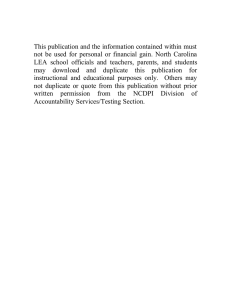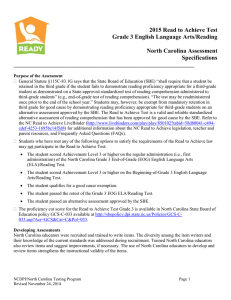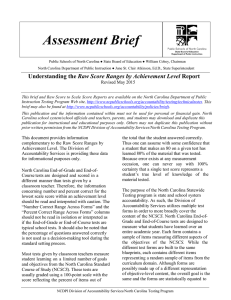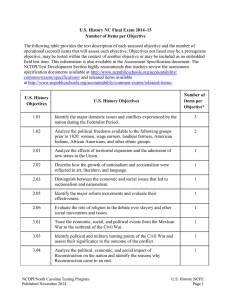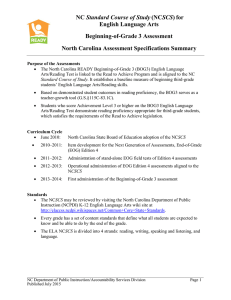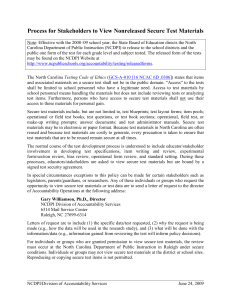Assessment Brief
advertisement
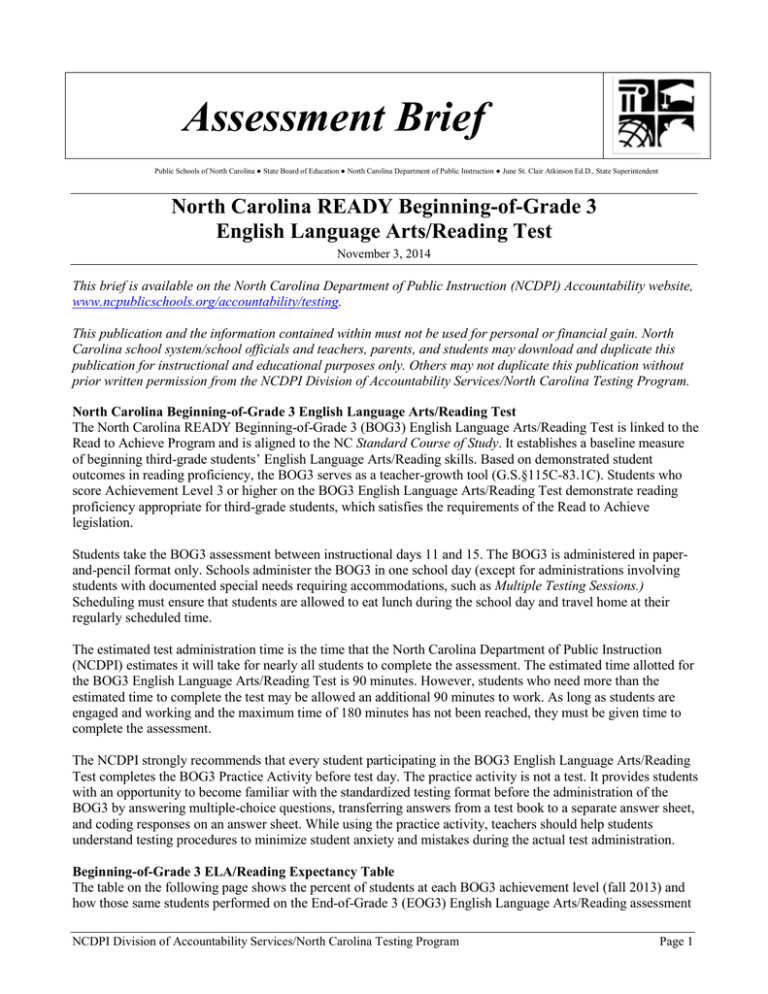
Assessment Brief Public Schools of North Carolina ● State Board of Education ● North Carolina Department of Public Instruction ● June St. Clair Atkinson Ed.D., State Superintendent North Carolina READY Beginning-of-Grade 3 English Language Arts/Reading Test November 3, 2014 This brief is available on the North Carolina Department of Public Instruction (NCDPI) Accountability website, www.ncpublicschools.org/accountability/testing. This publication and the information contained within must not be used for personal or financial gain. North Carolina school system/school officials and teachers, parents, and students may download and duplicate this publication for instructional and educational purposes only. Others may not duplicate this publication without prior written permission from the NCDPI Division of Accountability Services/North Carolina Testing Program. North Carolina Beginning-of-Grade 3 English Language Arts/Reading Test The North Carolina READY Beginning-of-Grade 3 (BOG3) English Language Arts/Reading Test is linked to the Read to Achieve Program and is aligned to the NC Standard Course of Study. It establishes a baseline measure of beginning third-grade students’ English Language Arts/Reading skills. Based on demonstrated student outcomes in reading proficiency, the BOG3 serves as a teacher-growth tool (G.S.§115C-83.1C). Students who score Achievement Level 3 or higher on the BOG3 English Language Arts/Reading Test demonstrate reading proficiency appropriate for third-grade students, which satisfies the requirements of the Read to Achieve legislation. Students take the BOG3 assessment between instructional days 11 and 15. The BOG3 is administered in paperand-pencil format only. Schools administer the BOG3 in one school day (except for administrations involving students with documented special needs requiring accommodations, such as Multiple Testing Sessions.) Scheduling must ensure that students are allowed to eat lunch during the school day and travel home at their regularly scheduled time. The estimated test administration time is the time that the North Carolina Department of Public Instruction (NCDPI) estimates it will take for nearly all students to complete the assessment. The estimated time allotted for the BOG3 English Language Arts/Reading Test is 90 minutes. However, students who need more than the estimated time to complete the test may be allowed an additional 90 minutes to work. As long as students are engaged and working and the maximum time of 180 minutes has not been reached, they must be given time to complete the assessment. The NCDPI strongly recommends that every student participating in the BOG3 English Language Arts/Reading Test completes the BOG3 Practice Activity before test day. The practice activity is not a test. It provides students with an opportunity to become familiar with the standardized testing format before the administration of the BOG3 by answering multiple-choice questions, transferring answers from a test book to a separate answer sheet, and coding responses on an answer sheet. While using the practice activity, teachers should help students understand testing procedures to minimize student anxiety and mistakes during the actual test administration. Beginning-of-Grade 3 ELA/Reading Expectancy Table The table on the following page shows the percent of students at each BOG3 achievement level (fall 2013) and how those same students performed on the End-of-Grade 3 (EOG3) English Language Arts/Reading assessment NCDPI Division of Accountability Services/North Carolina Testing Program Page 1 (by achievement level) at the end of the year (spring 2014). Readers can review how much progress students at each BOG3 achievement level made between the BOG3 and the EOG3 test administrations. Information is presented in rows. The table must be read from left to right across a single row starting at the BOG3 Achievement Levels column. The BOG3 Level 1 (scale score range 408-431) was divided into three smaller scale score ranges to differentiate levels of instructional need. The shaded cells indicate the achievement level a student is most likely to obtain given his/her BOG3 scale score. For example, 69 percent of students from the scale score range 408 to 421 on the BOG3 remained a Level 1 on the EOG3 and 23 percent of students from the scale score range 408 to 421 on the BOG3 progressed from a Level 1 to Level 2 on the EOG3. Eight percent of students from the scale score range 408 to 421 on the BOG3 became grade-level proficient on the EOG3. This table can be viewed as providing information about how third graders are expected to perform during the 2014–15 school year assuming students are randomly chosen within a BOG3 scale score range and that instruction remains unchanged from the 2013-14 school year. If schools reduce efforts for Level 2 BOG3 students, the 83% obtaining grade-level proficiency on the EOG3 may decrease. Schools should maintain or increase instructional support for BOG3 students at Levels 2 and above while increasing instructional support for BOG3 students at Level 1. Table of Percentages of Beginning-of-Grade 3 (BOG3) ELA/Reading Scale Scores by End-of-Grade 3 (EOG3) Achievement Levels Percent of Students at Each BOG3 Achievement Level/Scale Score Range (Fall 2013) BOG3 Achievement Levels BOG3 Scale Score Ranges Count (%) Percent of Students from Each BOG3 Scale Score Range Who Obtained Achievement Levels 1–5 on EOG3 (Spring 2014)* % at % at % at % at % at Level Level Level Level Level 1 2 3 4 5 Percent of Students from Each BOG3 Scale Score Range Who Obtained Grade-Level Proficiency on EOG3 (Spring 2014) 15,753 (15.2) 69 23 5 3 0 8 16,469 Level 1 422-427 (15.9) 37 37 14 11 0 25 16,031 428-431 (15.5) 12 36 23 28 1 52 23,600 Level 2 432-438 (22.8) 2 15 21 56 6 83 10,649 Level 3 439-441 (10.2) 0 4 10 69 16 95 18,391 Level 4 442-451 (17.8) 0 1 3 56 40 99 Level 5 452-461 2,501 (2.4) 0 0 0 27 73 100 103, 394 Total (100)** *The percentages in the EOG3 achievement level columns will sum to 100 across a given row. The columns cannot be summed. **The total count excludes records that did not have an EOG3 score and students who transferred from schools. All third graders with BOG3 scores and EOG3 scores within a school were included. 408-421 Quick Facts about the BOG3 English Language Arts/Reading Test The BOG3 is administered at grade 3. All BOG3 test questions are multiple-choice. Students are given two 3-minute stretch breaks during the regular test administration. The assessment is available only in paper-and-pencil format for the 2014–15 school year. Students read authentic selections and then answer questions related to the selections. The reading selections are comprised of literary and informational selections based on the North Carolina Standard Course of Study. NCDPI Division of Accountability Services/North Carolina Testing Program Page 2 Knowledge of vocabulary is assessed indirectly through application and understanding of terms within the context of the selection and questions. The assessment contains 42 total test items. ______________________________________________________________________________________________ In compliance with federal laws, NC Public Schools administers all state-operated educational programs, employment activities and admissions without discrimination because of race, religion, national or ethnic origin, color, age, military service, disability, or gender, except where exemption is appropriate and allowed by law. Inquiries or complaints should be directed to: Dr. Rebecca Garland, Deputy State Superintendent, Office of the Deputy State Superintendent, 6368 Mail Service Center, Raleigh, NC 27699-6368 Telephone (919) 807-3305; Fax (919) 807-4065. NCDPI Division of Accountability Services/North Carolina Testing Program Page 3
